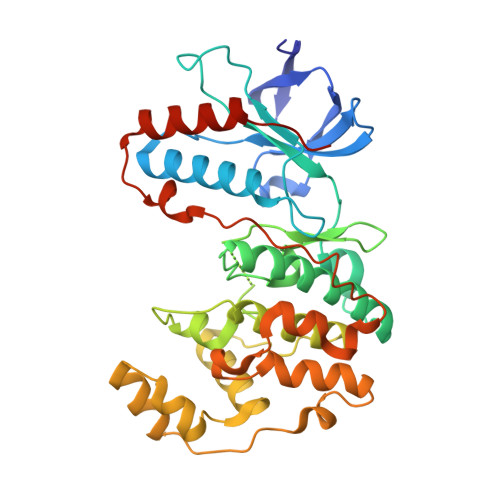Fluorophore labeling of the glycine-rich loop as a method of identifying inhibitors that bind to active and inactive kinase conformations.
Simard, J.R., Getlik, M., Grutter, C., Schneider, R., Wulfert, S., Rauh, D.(2010) J Am Chem Soc 132: 4152-4160
- PubMed: 20201574
- DOI: https://doi.org/10.1021/ja908083e
- Primary Citation of Related Structures:
3HUB, 3HUC, 3L8S - PubMed Abstract:
Targeting protein kinases with small organic molecules is a promising strategy to regulate unwanted kinase activity in both chemical biology and medicinal chemistry research. Traditionally, kinase inhibitors are identified in activity-based screening assays using enzymatically active kinase preparations to measure the perturbation of substrate phosphorylation, often resulting in the enrichment of classical ATP competitive (Type I) inhibitors. However, addressing enzymatically incompetent kinase conformations offers new opportunities for targeted therapies and is moving to the forefront of kinase inhibitor research. Here we report the development of a new FLiK (Fluorescent Labels in Kinases) binding assay to detect small molecules that induce changes in the conformation of the glycine-rich loop. Due to cross-talk between the glycine-rich loop and the activation loop in kinases, this alternative labeling approach can also detect ligands that stabilize inactive kinase conformations, including slow-binding Type II and Type III kinase inhibitors. Protein X-ray crystallography validated the assay results and identified a novel DFG-out binding mode for a quinazoline-based inhibitor in p38alpha kinase. We also detected the high-affinity binding of a clinically relevant and specific VEGFR2 inhibitor, and we provide structural details of its binding mode in p38alpha, in which it stabilizes the DFG-out conformation. Last, we demonstrate the power of this new FLiK labeling strategy to detect the binding of Type I ligands that induce conformational changes in the glycine-rich loop as a means of gaining affinity for the target kinase. This approach may be a useful alternative to develop direct binding assays for kinases that do not adopt the DFG-out conformation while also avoiding the use of expensive kits, detection reagents, or radioactivity frequently employed with activity-based assays.
Organizational Affiliation:
Chemical Genomics Centre of the Max Planck Society, Otto-Hahn-Strasse 15, D-44227 Dortmund, Germany.
















